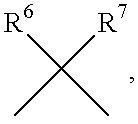Sulfonylamino acid derivatives
a technology of sulfonylamino acid and derivatives, which is applied in the field of sulfonylamino acid derivatives, can solve the problems that the substrate-analogue inhibitor might have various problems, and achieve the effect of safe pharmaceutical use and low toxicity of the compounds of the present invention
- Summary
- Abstract
- Description
- Claims
- Application Information
AI Technical Summary
Benefits of technology
Problems solved by technology
Method used
Image
Examples
reference example 1
N-[(4-Nitrophenyl)sulfonyl]glycine t-butyl ester ##STR490##
4-Nitrobenzenesulfonyl chloride (46.3 g) was added to a solution of glycine t-butyl ester hydrochloride (35 g) in pyridine (200 ml). The mixture was stirred for 1 hour at room temperature. The reaction mixture was concentrated. The precipitated crystals was washed with water and then a mixture of hexane and ethyl acetate (9:1) and dried to give the title compound (61.4 g) having the following physical data.
TLC: Rf 0.18 (Hexane: Ethyl acetate=4:1).
reference example 2
N-[(4-Aminophenyl)sulfonyl]glycine t-butyl ester ##STR491##
To a solution of the compound prepared in reference example 1 (57.1 g) in ethanol (200 ml) and tetrahydrofuran (200 ml), 10% palladium carbon (2.2 g) was added. The mixture was stirred for 3 hours at room temperature under an atmosphere of hydrogen. The reaction mixture was filtered through celite (registered trade mark). The filtrate was concentrated. The precipitated crystals was washed with a mixture of hexane and ethyl acetate (4:1) and dried to give the title compound (50 g) having the following physical data.
TLC: Rf 0.36 (Hexane:Ethyl acetate=1:1).
example 1
N-[[4-(p-Toluoylamino)phenyl]sulfonyl]glycine t-butyl ester ##STR492##
To a solution of the compound prepared in reference example 2 (1.2 g) in pyridine (10 ml), p-toluoyl chloride (0.5 ml) was added at 0.degree. C. The mixture was stirred for 30 minutes at room temperature. To the reaction mixture, 1N hydrochloric acid (100 ml) was added. The mixture was extracted with ethyl acetate. The extract was washed with a saturated aqueous solution of sodium bicarbonate, a saturated aqueous solution of sodium chloride, dried over anhydrous sodium sulfate and concentrated. The residue was washed with ether and dried to give the title compound (1.52 g) having the following physical data.
TLC: Rf 0.56 (Hexane:Ethyl acetate=1:1),
NMR (CDCl.sub.3): .delta. 8.08-8.00 (1H, br.s), 7.86 (2H, d, J=9.2Hz), 7.82 (2H, d, J=9.2 Hz), 7.78 (2H, d, J=8.2 Hz), 7.31 (2H, d, J=8.2 Hz), 5.04 (1H, t, J=5.4 Hz), 3.67 (2H, d, J=5.4 Hz), 2.44 (3H, s), 1.37 (9H, s).
PUM
| Property | Measurement | Unit |
|---|---|---|
| temperature | aaaaa | aaaaa |
| temperature | aaaaa | aaaaa |
| primary structure | aaaaa | aaaaa |
Abstract
Description
Claims
Application Information
 Login to View More
Login to View More - R&D
- Intellectual Property
- Life Sciences
- Materials
- Tech Scout
- Unparalleled Data Quality
- Higher Quality Content
- 60% Fewer Hallucinations
Browse by: Latest US Patents, China's latest patents, Technical Efficacy Thesaurus, Application Domain, Technology Topic, Popular Technical Reports.
© 2025 PatSnap. All rights reserved.Legal|Privacy policy|Modern Slavery Act Transparency Statement|Sitemap|About US| Contact US: help@patsnap.com



